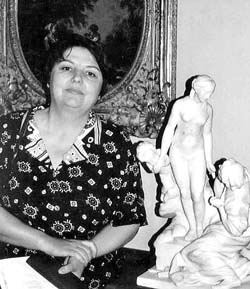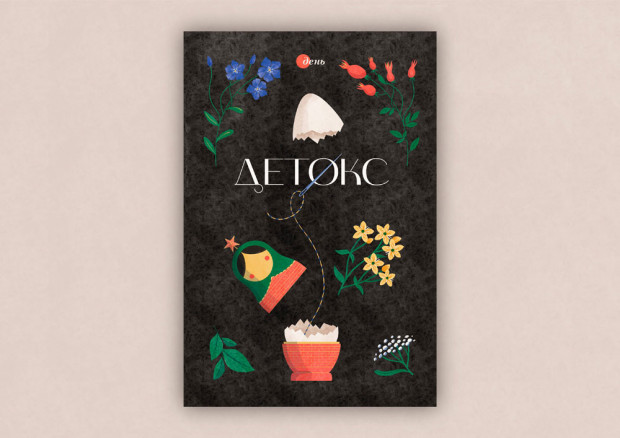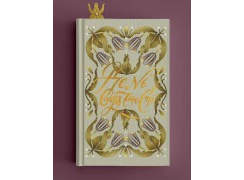No cliches
Talented Ukrainian-born painter founds art school in the US
Valentyna Sanina’s paintings and frescoes conceal another dimension — the romantic and subtle dreamworld of a painter, who has created her own impregnable ivory tower filled with charming ice princesses, delicate medieval ladies, and ancient beauties with flutes. The artist’s rich imagination and deep immersion into the multiple layers of the world and Ukrainian literature are elements that helped create her original language.
Sanina told The Day that her biography consists of a number of tests. She was born into a large family in the small provincial town of Kakhivka. Her parents devoted their lives to raising their many children, who since childhood were trained to work every day. She was different from other people because of her sensitivity to all forms of beauty. To a certain extent the beautiful nature of Ukraine also fostered her esthetic education: the blooming flowers of summer, the subtle color nuances during thaws, and the wondrous winter tracery of frost on windows on Christmas Eve.
The Dnipro River was a separate source of inspiration for Sanina, with its turbulent rapids and boundless expanses of the daytime sky above its changeable waters, mysterious colors of early evening, the reflection of night stars, and the dignified moon. She thus absorbed all the beauty of the Ukrainian lands. Her studies at the Symferopil Art School were the first step to fulfilling her cherished dream to become an artist.
While gaining proficiency in the main principles of pictorial art, she mastered every tip from her teachers, among whom were experienced specialists. Later she enrolled at the Kharkiv Art Institute, from where she graduated with an honors diploma. A commendable attitude to her chosen profession, inner discipline, and diligence guaranteed success for Sanina in the following years.
Her further development as an artist took place in Kyiv. There she joined her creative destiny with an architecture institute, where she worked in the monumental department. (Her works still embellish some buildings located in Kyiv’s historical center.) Sanina’s 10-meter-high ceramic triptych Protect the Child won first place in the traditional nomination for Best Work of the Year award. Her success was especially significant because, as all artists know, an artist has to go through different “tribulations,” proceeding from a sketch to the actually embodiment of the creative idea. However, Sanina’s firm and steadfast character helped her overcome all difficulties.
In Ukraine during the 1960s there was a whole group of artists, including Alla Horska, who became famous for her monumental abstract and figurative mosaics and stained-glass windows. Together with her fellow artists Viktor Zaretsky, Liudmyla Semykina, and Opanas Zalyvakha, Horska introduced a new revolutionary understanding of art. Their work proved that an artist’s personal vision goes beyond censorship and the boring monotony of government- approved cliches. The brilliant individuality of Sanina, who is an heir to the best creative discoveries of the Ukrainian monumental school, as well as her diligence, helped her to create her individualized figurative language.
Sanina has produced numerous monumental works, among them four colorful panels on the subject of childhood (in Tiumen) and the extremely beautiful and expressive stained-glass windows in the International Sports Center in Vorokhta, western Ukraine.
With time, Sanina, her husband — furniture designer Borys Hurvich — and her daughter Olha, who obtained an international artistic education, immigrated to the United States. While mastering the new and unusual environment, the artist had an opportunity to continue developing Ukraine’s finest artistic traditions abroad by opening her own art school in Des Plaines, a suburb of Chicago district. Today this establishment is working successfully and producing talented students, who have a high regard for the school’s founder and teacher. They are enthusiastically continuing her artistic “line” without sacrificing their individuality.
Besides working at the school, Sanina continues to work on monumental and easel painting. She has created a variety of commissioned frescoes, such as a charming beauty with a flute, flowers with a medieval building in the background (the fresco Diana) — all born in the refined imagination of an artist who continues to dream from the heights of her own ivory tower. Neither age nor life experiences have influenced this gifted artist’s romantic world-view.
Characteristically, the spectrum of Sanina’s artistic quests is not limited to monumental paintings. In her free time she continues to work on easel paintings. Using acrylic paints on canvas and watercolors on paper, she has created a number of works. A fascinating feature of her easel paintings is the principle of dualism, i.e., double rendering, contrary to the traditionally single classical center of composition and content. Taras Shevchenko is depicted in her painting Dumy moi, dumy. Next to the Kobzar’s portrait (the artist’s favorite poet and writer) is Kateryna, holding a baby. We observe the same compositional scheme in the extremely romantic picture Through the Centuries, a beautiful look back at the medieval era, executed in watercolors. The painting shows a male silhouette in the background. In the foreground is a sophisticated, fragile lady, who seems to be enveloped in reminiscences and dreams. The subtle color nuances produce a sense of keen nostalgia and high spirits.
The painting Actress (acrylic on paper) is also part of Sanina’s gallery of female images. The abstract ornamentation of the stained-glass windows in the background and somewhat darkened coloring of the picture create an original enclosed world of associations with the works of world theatrical and cinematic arts.
The world of folk music is the main theme in the picture Summer. A beautiful young girl is playing the reed-pipe with such inspiration and tenderness that a bird listens to the song attentively, and a white horse gazes at her with his deep brown eyes. The richness of the content, complex rhythmic structure, and the harmonious blend of turquoise, green, and pink colors show that the painter has succeeded in recreating the atmosphere of a fascinating fairy tale. The folkloristic origins of this painting lead us to the origins of Ukrainian culture, helping us recall the finest things created by the people’s poets, songwriters, and painters.
Even overseas Valentyna Sanina has not forgotten her native roots. The romantic world of her pictures has not been lost within the pleiad of foreign artists.






